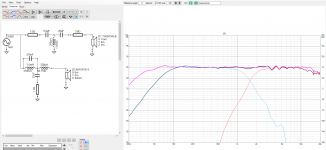Turk-182: Here is an example I went through quite recently... This more or less confirms what Allen is saying.
I made an active DSP 3 way system, and after it was complete, I designed a passive crossover for the mid-woofer and tweeter. In the attached graphic, the purple curve is the simulation for the active DSP filter (including subwoofer). The black curve is the simulation for the passive crossover.
There are obvious differences below 100 Hz, as expected. There is also some DSP EQ'ing above 10k that is visible in the purple curve. I am not that skilled, but I was able to match the slopes of the DSP crossover using passive components, in this case 24 dB/octave slopes at 1600 Hz.
I expect that if I built this passive crossover, I might need to tweek the level on the tweeter a bit, perhaps by 1 or 2 dB. This always seems to be the case with me. But I would expect basically the same performance from the passive network as the active network.
Does this make sense?
j.
I made an active DSP 3 way system, and after it was complete, I designed a passive crossover for the mid-woofer and tweeter. In the attached graphic, the purple curve is the simulation for the active DSP filter (including subwoofer). The black curve is the simulation for the passive crossover.
There are obvious differences below 100 Hz, as expected. There is also some DSP EQ'ing above 10k that is visible in the purple curve. I am not that skilled, but I was able to match the slopes of the DSP crossover using passive components, in this case 24 dB/octave slopes at 1600 Hz.
I expect that if I built this passive crossover, I might need to tweek the level on the tweeter a bit, perhaps by 1 or 2 dB. This always seems to be the case with me. But I would expect basically the same performance from the passive network as the active network.
Does this make sense?
j.
Attachments
point taken ... but until a final solution is arrived at losing the ability to vary parameters is more what i was driving at but for the OP it's less of an issue with his Dayton DSP module.
i have in the past done the same tried to make a passive perform like an active but for me insertion losses could not be countered and the steeper the filter the greater the loss, why lose SPL to reactive components that don't need to be there in an active version?
sorry to the OP for the sidebar discussion.
i have in the past done the same tried to make a passive perform like an active but for me insertion losses could not be countered and the steeper the filter the greater the loss, why lose SPL to reactive components that don't need to be there in an active version?
sorry to the OP for the sidebar discussion.
You couldn't use inductors??
i take it that question was directed to me?
Turk if you are going to make the case that with DSP active speakers, it is faster to get a good, acceptable design, I agree completely.
I also believe that with DSP active systems it is possible to optimize to the highest level of performance with a given set of drivers. With passive systems this is also possible, but much more difficult. A skilled designer will have a better chance of achieving an optimized design with active DSP than he will with a passive network.
Active DSP filter systems are not a magic wand. We need to know what we are doing. There is a certain amount of marketing hype (and self generated hype) that leads some people to believe that putting together a DSP filter is a simple cook-book checklist. Not so. But it is faster, and easier, than a passive system.
j.
I also believe that with DSP active systems it is possible to optimize to the highest level of performance with a given set of drivers. With passive systems this is also possible, but much more difficult. A skilled designer will have a better chance of achieving an optimized design with active DSP than he will with a passive network.
Active DSP filter systems are not a magic wand. We need to know what we are doing. There is a certain amount of marketing hype (and self generated hype) that leads some people to believe that putting together a DSP filter is a simple cook-book checklist. Not so. But it is faster, and easier, than a passive system.
j.
that it's faster easier via DSP is self evident, not to parse it more but "active" can be a PLLXO with amps, and that would still be better easier and less costly that a speaker level passive x-over IMHO.
- Home
- Loudspeakers
- Multi-Way
- Plans for an active 3 way speaker
